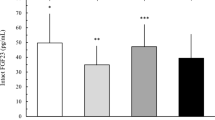Abstract
Growth retardation in children with chronic renal failure (CRF) is partly due to an inhibition of insulin-like growth factor (IGF) activity by an excess of high-affinity IGF-binding proteins (IGFBPs). The aim of this study was to analyze the serum levels and forms of IGFBP-4 and IGFBP-5 in CRF patients using specific, recently developed radioimmunoassays (RIAs) and immunoblot analysis. We examined 89 children [age 11.5 (2.8–19.0) years] with CRF [glomerular filtration rate 26.6 (7.0–67.4) ml/min per 1.73 m2], nine of them with end-stage renal disease undergoing peritoneal dialysis. Serum-immunoreactive IGFBP-4 levels were fourfold increased in CRF (prepubertal 1080±268 ng/ml; pubertal 989±299 ng/ml) compared to healthy prepubertal controls (265±73 ng/ml). In contrast, serum IGFBP-5 levels were not significantly increased neither in prepubertal (361±120 ng/ml vs 282±75 ng/ml in controls) nor pubertal CRF children (478±165 ng/ml vs 491±80 ng/ml in controls). Immunoblot analysis showed the presence of intact as well as fragmented IGFBP-4 and IGFBP-5. Serum IGFBP-4, but not IGFBP-5, levels were inversely correlated with GFR (r=–0.39, P<0.001). In prepuber- tal children, IGFBP-4 levels were inversely correlated with standardized height (r=–0.40; P<0.005). In contrast, IGFBP-5 levels were positively correlated both with standardized height (r=0.32, P<0.02) and baseline height velocity (r=0.45, P<0.005). A 3-month therapy with rhGH stimulated serum IGFBP-5 levels by 43% (P<0.01); there was no consistent effect on IGFBP-4 levels. There was a positive correlation between IGFBP-4 and IGFBP-2 (r=0.46, P<0.001); IGFBP-5 was positively correlated with IGF-I (r=0.59, P<0.001), IGF-II (r=0.42, P<0.001) and IGFBP-3 (r=0.47, P<0.001) and inversely correlated with IGFBP-1 (r=–0.41, P<0.001). In summary, serum IGFBP-4 is fourfold elevated in children with CRF in relation to the degree of renal dysfunction and contributes to the marked increase in IGF-binding capacity in CRF serum. The inverse correlation of serum IGFBP-4 with standardized height is consistent with its role as another inhibitor of the biological action of the IGFs on growth plate cartilage. In contrast, serum IGFBP-5 is not elevated in CRF serum and circulates mainly as proteolysed fragments. The positive correlation of serum IGFBP-5 with growth and its increase during GH therapy indicate that IGFBP-5 is a stimulatory IGFBP in patients with CRF, either by enhancing IGF activity through better presentation of IGF to its receptor or by an IGF-independent effect through activation of a specific, recently described putative IGFBP-5-receptor.
Similar content being viewed by others
Author information
Authors and Affiliations
Consortia
Additional information
Received: 24 September 1999 / Revised: 6 January 2000 / Accepted: 13 January 2000 / Accepted: 13 January 2000
Rights and permissions
About this article
Cite this article
Ulinski, T., Mohan, S., Kiepe, D. et al. Serum insulin-like growth factor binding protein (IGFBP)-4 and IGFBP-5 in children with chronic renal failure: relationship to growth and glomerular filtration rate. Pediatr Nephrol 14, 589–597 (2000). https://doi.org/10.1007/s004670000361
Issue Date:
DOI: https://doi.org/10.1007/s004670000361




